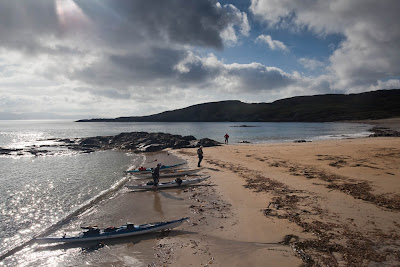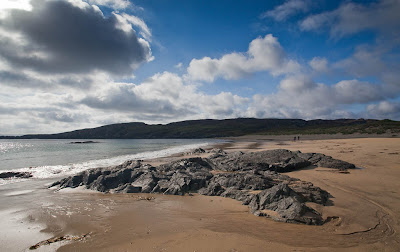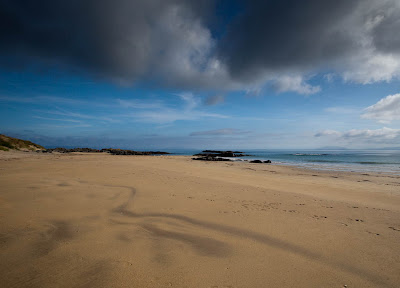At the Scottish Canoe show in Perth, I saw a very interesting kayak on the Kari-Tek stand. It was a shiny Rockpool Alaw Bach, though it lacked the glitter finish. Closer inspection showed that it was made out of a moulded material called Carbonite 2000 that is used in the aircraft industry. This is a thermoformed trilaminate of ABS plastic and acrylic. It gives a stiff, light hull with a high degree of UV, impact and abrasion resistance. It is said to be easily repairable but I do not have details. Kayaks in Carbonite 2000 are likely to be up to 20% cheaper than traditional, hand lay up, GRP composite Kayaks. Eddyline in the USA first introduced sea kayaks in this material in 1996.
The moulding machines are ultra expensive but the labour cost in producing each kayak is low. Clearly the accuracy with which the mould reproduces the original design will be paramount to the performance of these kayaks but this looks like a glimpse of the future for UK sea kayaks.
Given Mike Webb's acknowledged guru status in the World of GRP kayaks, I think it very significant that Rockpool, of all British manufacturers, was showing a kayak in Carbonite 2000. I understand that other UK manufacturers, like P&H and Valley, are also seriously considering this production method.
Imagine you are at the edge of the sea on a day when it is difficult to say where the land ends and the sea begins and where the sea ends and the sky begins. Sea kayaking lets you explore these and your own boundaries and broadens your horizons. Sea kayaking is the new mountaineering.
Sunday, October 25, 2009
Glassard and a wooly welcome to Scalasaig, Colonsay

We continued SE along Colonsay's coast line after leaving the abandoned fishing village of Riasg Buidhe. We came upon the planned township of Glassard (Glas Aird) to which, the former residents of Riasg Buidhe moved. Each new croft house had its own hay meadow and the men folk were able to use bigger fishing boats which were kept in nearby Scalasaig harbour.
A recent survey showed that Colonsay had 89 houses of which, 39 were holiday homes. Some of the Glassard crofts are now holiday homes or lets and gradually the old family links to Riasg Buidhe are being lost. Hay was last cut in Glassard over 15 years ago and now the meadows, with their profusion of wild flowers, are being invaded by bracken.

It was nearing time for second luncheon and we now approached the capital of Colonsay, Scalasaig, with some anticipation.

We paddled between the sheltering arms of Scalasaig's harbour and landed at a little beach at its head. The only fishing vessel currently registered with its home port as Colonsay is CN183 Sea Spray. She is a 7m wooden creel fisher built in 1960. You can just see her red hull at the back of the line of moored boats.

We walked up towards the main road and prepared to meet the locals. Would there be any formalities attached with our arrival? Would carnets need to be stamped?
We were met by a small welcoming committee, who were sheltering in the shade of what we presumed to be the custom house. They appeared to be taking a siesta, so we moved forward slowly to pass. Their leader cast a disdainful eye over our salt encrusted Goretex paddling gear but, without comment, slowly stood aside to let us through.
We had arrived in Scalasaig!
Saturday, October 24, 2009
A little bowed but still standing at Riasg Buidhe, Colonsay

From the beach we made our way up the hillside to the abandoned village of Riasg Buidhe on Colonsay.

The street which had once been flagged with paving stones was now covered with grass. empty windows and doors looked out over the sea to Jura. The roofs of the houses were long gone. Only the first two houses had gables with stone chimneys.

A little apart from the other houses, this cottage still had a tree growing at the bottom of its yard.

This view from 1900 was taken from the hill behind the cottage in my photo above. At this time the first two cottages in the main street had thatched roofs without stone chimneys.

Some houses had plain dry stone walls like this one with children outside.

Others, like this one, were whitewashed. The prime occupation in the village was fishing. The village was abandoned in 1918 and the inhabitants were resettled at Glassard, which is near Colonsay's capital, Scalasaig. It reminded me of St Kilda, but unlike that island, little is published about the history of Riasg Buidhe.

This photo was taken in 10 years later in 1910. You can see houses 1 and 2 now have corrugated iron roofs and the thatched roof of house 4 has collapsed. You can see a tree in the front yard of the isolated cottage in the foreground. If, as I suspect, it is the same tree we saw, it is a little bowed but still standing after 100 years!
As we made our way round Colonsay, we realised that we were landing at the same spots as our ancestors had chosen. They after all were also journeying by small craft. Some had lived relatively recently, such as the fisherfolk at Riasg Buidhe. We were shortly to discover where some had lived 9,000 years ago!
I think it is important when sea kayaking to keep a look out for landing sites. Don't just pass them by, on a headlong, headland to headland, dash. Take time to stop and explore, your voyage may take longer but you will be all the richer for it.
Bibliographic footnote:
The bottom photo was taken by by Mary Ethel Muir Donaldson (1876-1958). She published a number of books of photographs and writings including:
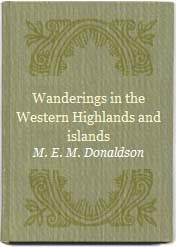
"Wanderings in the Western Highlands and Islands:recounting Highland and clan history traditions, ecclesiology, archæology, romance, literature, humour, folk-lore, &c. " in 1920 and...

"Further wanderings, mainly in Argyll: recounting Highland history, traditions, ecclesiology, archaeology, romance, present conditions, crofters' life, and wild life, humour, literature, folk-lore, &c" in 1926.
Thursday, October 22, 2009
The last tennant of Riasg Buidhe, a spider.

We spied a ruined village at Riasg Buidhe on the NE coast of Colonsay.

It looked an interesting spot to explore, so we landed at a little gravel beach at the end of...

...a narrow channel, which in places had been hewn from the rocks to create a little harbour.

The rocks rose steeply from the shore...

...and there was only room for a tiny building which looked like it had been a store.

The only sign of life was this spider, which had spun its web in a nearby cave.
Wednesday, October 21, 2009
The Armada and Spanish goats on NE Colonsay

Our little Armada of kayaks made its way down the NE coast of Colonsay in the most glorious of conditions.

In the distance, the hills of Islay floated above a limpid sea.

As the kilometers slipped gently by, we passed Eilean Olmsa. It was quite difficult deciding which side to pass it on.

A large yacht resorted to its engine after drifting in the tide, its limp sails had produced no propulsion.
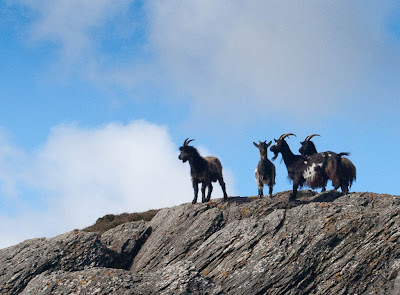
We rounded a headland to discover that our progress was being observed by these goats. Although they are now feral, they are reputed to be descendants of a flock of goats that survived the wrecking of one of the great ships of the Spanish Armada in 1588.
Tuesday, October 20, 2009
Better days: the wreck of the Wasa

We spent some time exploring...

...the magnificent strand of Balnahard beach on Colonsay.

Below the high water mark we found the remains of a wooden steamship, the SS Wasa. In 1919 she caught fire and was being towed to safety when she stranded here and was lost.

In this view you can see Scarba on the left, the Gulf of Corryvreckan and Jura to the right. We would have liked to have stayed all day but we knew we had to get to the south end of Colonsay and cross the 15km to Jura before night fall. We prepared to put to sea again, unlike the Wasa, which has seen better days.
